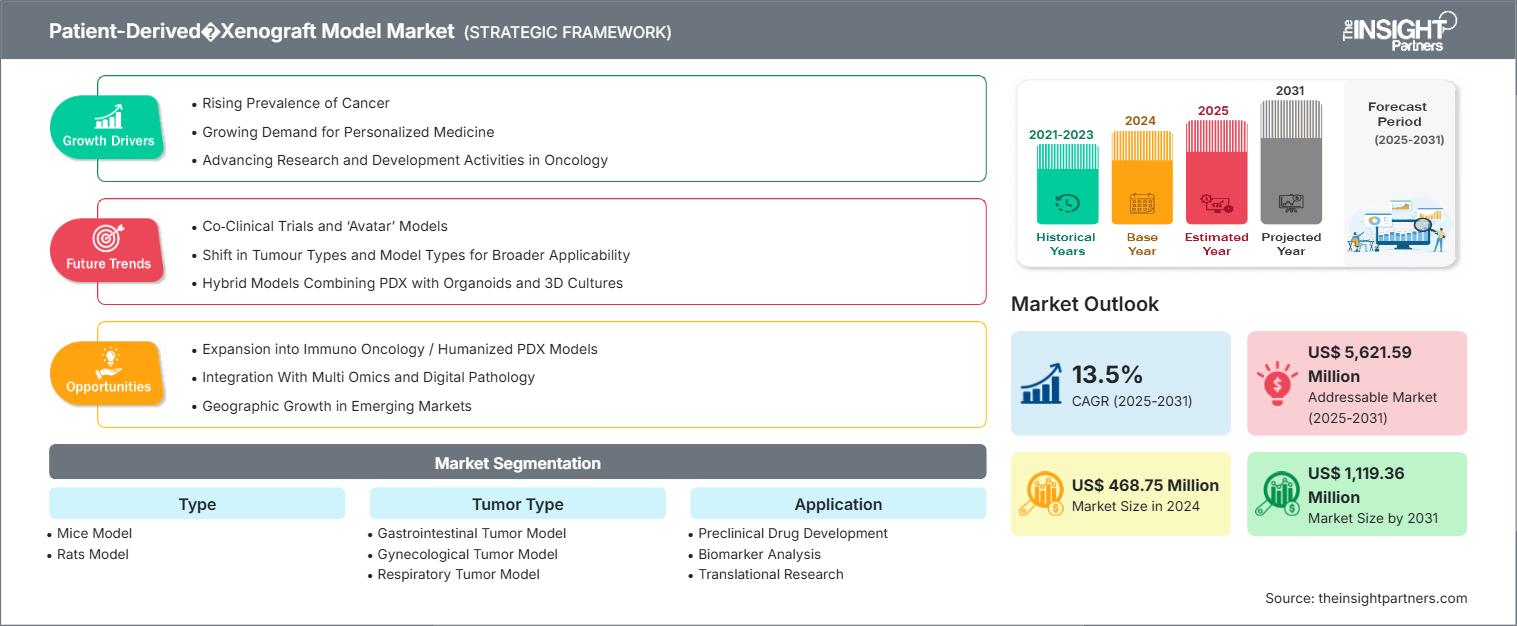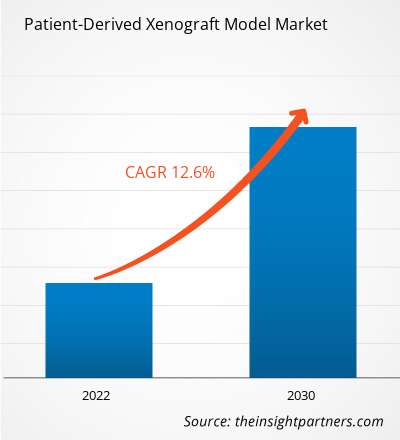Der Markt für patientenabgeleitete Xenotransplantatmodelle wird bis 2031 voraussichtlich ein Volumen von 1.119,36 Millionen US-Dollar erreichen, gegenüber 468,75 Millionen US-Dollar im Jahr 2024. Es wird erwartet, dass der Markt im Zeitraum 2025–2031 eine durchschnittliche jährliche Wachstumsrate (CAGR) von 13,5 % verzeichnen wird.
Marktanalyse für patientenabgeleitete Xenograft-Modelle
Der weltweite Bedarf an patientenabgeleiteten Xenograft-Modellen (PDX) wird maßgeblich beeinflusst durch die zunehmende Anzahl onkologischer Entwicklungspipelines, die prädiktivere In-vivo-Plattformen erfordern, die rasante Entwicklung der personalisierten Medizin, die wiederum patientenspezifische Tumormodelle benötigt, und die wachsende Auslagerung präklinischer Tests an spezialisierte CROs, die PDX-Dienstleistungen auf skalierbarer Basis anbieten.
Marktübersicht für patientenabgeleitete Xenotransplantatmodelle
Der globale Markt für patientenabgeleitete Xenograft-Modelle (PDX) befindet sich in einem tiefgreifenden Wandel. Pharma- und Biotechnologieunternehmen setzen zunehmend auf repräsentativere, aus menschlichen Tumoren gewonnene Plattformen. Diese Plattformen bewahren genetische und mikroökologische Merkmale, die in traditionellen Zelllinien nicht vorhanden sind. Angesichts der steigenden Krebsfälle, der Nachfrage nach Präzisionstherapien und der zunehmenden Anerkennung translationaler Modelle durch die Zulassungsbehörden sind PDX-Plattformen in der präklinischen Wirkstoffforschung, der Biomarkeridentifizierung und der Untersuchung von Therapieresistenzen unverzichtbar geworden. Ihre Expansion wird zudem durch Fortschritte in der Genomprofilierung, die Verwendung immunkompetenter menschlicher Wirte und große Gewebebanken von Patiententumoren unterstützt.
Sie erhalten eine kostenlose Anpassung aller Berichte – einschließlich Teilen dieses Berichts, Länderanalysen und Excel-Datenpaketen – sowie attraktive Angebote und Rabatte für Start-ups und Universitäten.
Markt für patientenabgeleitete Xenograft-Modelle: Strategische Einblicke

-
Ermitteln Sie die wichtigsten Markttrends dieses Berichts.Diese KOSTENLOSE Probe beinhaltet eine Datenanalyse, die von Markttrends bis hin zu Schätzungen und Prognosen reicht.
Markttreiber und Chancen für patientenabgeleitete Xenograft-Modelle
Markttreiber:
- Zunehmende Krebsprävalenz: Die weltweit steigende Zahl von Krebsfällen ist ein wesentlicher Faktor für die wachsende Nachfrage nach effektiven präklinischen Modellen wie PDX. Solche präklinischen Modelle sind hilfreich, um das Tumorverhalten zu verstehen und neue Therapien zu testen.
- Wachsende Nachfrage nach personalisierter Medizin: Der Bedarf an personalisierten Behandlungsmethoden erfordert den Einsatz von Modellen, die präzise sind und den spezifischen Tumor des Patienten repräsentieren. Dies führt zu einer verstärkten Nutzung von PDX-Modellen in der Arzneimittelentwicklung und Therapieoptimierung.
- Förderung von Forschungs- und Entwicklungsaktivitäten in der Onkologie: Die weltweit zunehmenden Forschungs- und Entwicklungsinitiativen im Bereich der Onkologie treiben vor allem den Einsatz von PDX-Modellen beim Testen neuer Medikamente und beim Erreichen eines tieferen Verständnisses der Krebsbiologie voran.
Marktchancen:
- Expansion in die Immunonkologie / Humanisierte PDX-Modelle: Die Integration eines menschlichen Immunsystems in PDX-Modelle ermöglicht die Testung von Immuntherapien. Dies stellt ein neu entstehendes Gebiet im Bereich der Immunonkologie dar und birgt somit das Potenzial für eine signifikante Umsatzsteigerung.
- Integration mit Multi-Omics und digitaler Pathologie: Die Integration von PDX-Modellen mit genomischen, proteomischen und digitalen Pathologiedaten dient der Verbesserung der Tumorprofilierung und beschleunigt die Möglichkeiten der Präzisionsmedizinforschung.
- Geografisches Wachstum in Schwellenländern: Der Ausbau der Gesundheitsinfrastruktur und Investitionen in die Krebsforschung in aufstrebenden Regionen schaffen erhebliche Marktexpansionsmöglichkeiten für die Anwendung des PDX-Modells.
Marktbericht zum patientenabgeleiteten Xenograft-Modell: Segmentierungsanalyse
Der Markt für patientenabgeleitete Xenotransplantatmodelle ist in verschiedene Kategorien unterteilt, um ein besseres Verständnis seiner Funktionsweise, seines Wachstumspotenzials und seiner aktuellen Trends zu ermöglichen. Nachfolgend ist der in Branchenberichten übliche Segmentierungsansatz dargestellt:
Nach Typ:
- Rattenmodell: Das PDX-Modell der Ratte gewinnt zunehmend an Bedeutung, da Ratten größere Gewebevolumina, eine höhere anatomische Komplexität und Eignung für Langzeitstudien bieten. Diese Faktoren sind sowohl für komplexe Tumorarten als auch für die chirurgische und pharmakokinetische Forschung von großem Nutzen.
- Mausmodell: Das Segment der Mausmodelle hält einen bedeutenden Marktanteil. Dies ist auf die Verfügbarkeit etablierter immundefizienter Mausstämme, die einfachere Manipulation genetischer Informationen, die Kosteneffizienz des Verfahrens und die breite Anwendung dieser Modelle in der onkologischen Arzneimittelentwicklung zurückzuführen.
Nach Tumorart:
- Gastrointestinale Tumormodelle: Dieser Abschnitt umfasst PDX-Modelle für Tumoren des Verdauungstrakts, wie z. B. Kolorektal-, Magen- und Pankreaskrebs. Ihre zunehmende Verbreitung ist vor allem auf die hohe Inzidenz in diesen Bereichen und den dringenden Bedarf an zielgerichteten Therapien zur Behandlung komplexer gastrointestinaler Malignome zurückzuführen.
- Gynäkologisches Tumormodell: Es umfasst PDX-Modelle für Tumoren der weiblichen Fortpflanzungsorgane, wie z. B. Eierstock- und Gebärmutterschleimhauttumoren. Seine Erweiterung ist eine Folge des verstärkten Forschungsschwerpunkts auf Krebserkrankungen bei Frauen und des Bedarfs an prädiktiveren präklinischen Modellen.
- Respiratorisches Tumormodell: Unter respiratorischen Tumormodellen versteht man PDX-Modelle von Lungentumoren und anderen Tumoren der Atemwege. Dieser Bereich wächst rasant aufgrund steigender Lungenkrebsfälle und erheblicher Investitionen in die Forschung im Bereich der respiratorischen Onkologie.
- Andere Tumormodelle: Hierbei handelt es sich um eine Sammlung von PDX-Modellen, die seltenere oder unspezifische Tumoren wie Sarkome, Kopf-Hals-Tumoren und Melanome repräsentieren. Ihr Wachstum wurde durch die Vertiefung spezialisierter onkologischer Bereiche, die Diversifizierung der PDX-Anwendungen und die Erweiterung der Forschungspipelines begünstigt.
Auf Antrag:
- Präklinische Arzneimittelentwicklung
- Biomarkeranalyse
- Übersetzungsforschung
- Biobanking
Vom Endbenutzer:
- Pharma- und Biotechnologieunternehmen
- Akademiker und Forschungsinstitute
- Auftragsforschungsorganisationen
Nach Geographie:
- Nordamerika
- Europa
- Asien-Pazifik
- Süd- und Mittelamerika
-
Naher Osten und Afrika
Markt für patientenabgeleitete Xenograft-Modelle: Regionale Einblicke
Die regionalen Trends und Einflussfaktoren auf den Markt für patientenabgeleitete Xenotransplantatmodelle im gesamten Prognosezeitraum wurden von den Analysten von The Insight Partners eingehend erläutert. Dieser Abschnitt behandelt außerdem die Marktsegmente und die geografische Verteilung des Marktes für patientenabgeleitete Xenotransplantatmodelle in Nordamerika, Europa, Asien-Pazifik, dem Nahen Osten und Afrika sowie Süd- und Mittelamerika.
Berichtsumfang zum Markt für patientenabgeleitete Xenotransplantatmodelle
| Berichtattribute | Details |
|---|---|
| Marktgröße im Jahr 2024 | 468,75 Millionen US-Dollar |
| Marktgröße bis 2031 | 1.119,36 Millionen US-Dollar |
| Globale durchschnittliche jährliche Wachstumsrate (2025 - 2031) | 13,5 % |
| Historische Daten | 2021-2023 |
| Prognosezeitraum | 2025–2031 |
| Abgedeckte Segmente |
Nach Typ
|
| Abgedeckte Regionen und Länder |
Nordamerika
|
| Marktführer und wichtige Unternehmensprofile |
|
Marktteilnehmerdichte bei patientenabgeleiteten Xenograft-Modellen: Auswirkungen auf die Geschäftsdynamik verstehen
Der Markt für patientenabgeleitete Xenotransplantatmodelle wächst rasant, angetrieben durch die steigende Nachfrage der Endverbraucher. Gründe hierfür sind unter anderem sich wandelnde Verbraucherpräferenzen, technologische Fortschritte und ein wachsendes Bewusstsein für die Vorteile des Produkts. Mit steigender Nachfrage erweitern Unternehmen ihr Angebot, entwickeln innovative Lösungen, um den Verbraucherbedürfnissen gerecht zu werden, und nutzen neue Trends, was das Marktwachstum zusätzlich beflügelt.

- Überblick über die wichtigsten Akteure im Markt für patientenabgeleitete Xenograft-Modelle
Marktanteilsanalyse für patientenabgeleitete Xenograft-Modelle nach Regionen
Der asiatisch-pazifische Raum wird voraussichtlich in den nächsten Jahren das schnellste Wachstum verzeichnen. Schwellenländer in Südamerika, dem Nahen Osten und Afrika bieten PDX-Anbietern ungenutzte Expansionsmöglichkeiten.
Das Wachstum des Marktes für patientenabgeleitete Xenograft-Modelle variiert regional aufgrund von Faktoren wie der steigenden Krebsinzidenz und der zunehmenden pharmazeutischen Forschung und Entwicklung, kombiniert mit staatlicher Förderung der Präzisionsmedizin und kosteneffizienten CRO-Dienstleistungen. Nachfolgend finden Sie eine Zusammenfassung der Marktanteile und Trends nach Region:
1. Nordamerika
- Marktanteil: Besitzt einen bedeutenden Anteil am Weltmarkt
- Wichtigste Einflussfaktoren: Die Krebsforschung wurde stark finanziert, die Biotech-/Pharmabranche ist ausgereift und PDX hat sich weit verbreitet.
- Trends: Humanisierte Maus-PDX-Modelle werden zunehmend eingesetzt, KI/Biomarker-Workflows werden integriert und CRO-Outsourcing nimmt zu.
2. Europa
- Marktanteil: Bedeutender Marktanteil
- Wichtigste Einflussfaktoren: Zunehmender Einsatz von Präzisionsmedizin, Zusammenarbeit zwischen translationalen Onkologienetzwerken und eine etablierte akademische Forschungsbasis.
- Trends: Standardisierung von PDX-Protokollen in verschiedenen Ländern, Zunahme von Biobanking-Initiativen und regulatorischer Fokus auf Reproduzierbarkeit und Ethik.
3. Asien-Pazifik
- Marktanteil: Am schnellsten wachsende Region mit jährlich steigendem Marktanteil.
- Wichtigste Einflussfaktoren: Rasch steigende Krebsfälle, wachsende Investitionen in die Forschung und Entwicklung im Gesundheitswesen sowie die Expansion der Pharma- und Biotechnologiebranche.
- Trends: Neu entwickelte CRO-Zentren, die PDX-Dienstleistungen zu niedrigen Preisen anbieten, Fortschritte bei lokalen Biobanken und multinationale Kooperationen für neuartige Krebsarten.
4. Süd- und Mittelamerika
- Marktanteil: Wachsender Markt mit stetigem Fortschritt
- Wichtigste Einflussfaktoren: Die zunehmende Belastung durch Krebserkrankungen in Verbindung mit einer verbesserten Forschungsinfrastruktur führt zu einem starken Anstieg der Auslagerung der präklinischen Modellentwicklung durch globale Sponsoren.
- Trends: Zunehmende Nutzung von PDX-Diensten, Kooperation mit internationalen Modellanbietern und die zunehmende Berücksichtigung regionaler Tumormodelle.
5. Naher Osten und Afrika
- Marktanteil: Kleine Marktgröße, aber schnelles Wachstum
- Wichtigste Einflussfaktoren: Erhöhte staatliche Investitionen in die Präzisionsonkologie, die Einrichtung weiterer Forschungszentren und eine wachsende Anzahl klinischer Studien im Bereich der Onkologie.
- Trends: Einsatz von PDX-Modellen in Nischenprojekten (z. B. seltene Tumore, HIV-assoziierte Malignome), regionalen Biobankprogrammen und Infrastrukturausbau für translationale Forschung.
Marktteilnehmerdichte bei patientenabgeleiteten Xenograft-Modellen: Auswirkungen auf die Geschäftsdynamik verstehen
Hohe Marktdichte und starker Wettbewerb
Der Wettbewerb ist aufgrund der Präsenz etablierter Akteure wie Charles River Laboratories International Inc. und Crown Bioscience Inc. stark. Regionale und spezialisierte Anbieter tragen zur Wettbewerbslandschaft in allen Regionen bei.
Der hohe Wettbewerbsdruck zwingt Unternehmen dazu, sich durch folgende Angebote von der Konkurrenz abzuheben:
- Produktinnovation
- Produktzulassungen
- Einhaltung der regulatorischen Richtlinien
Chancen und strategische Schritte
- Durch gezielte Medizin kann der Markt für PDX-Modelle vielversprechend wachsen. Gezielte Medizin ermöglicht präzise Arzneimitteltests, und Patienten weltweit können so die bestmögliche Krebsbehandlung erhalten.
- Durch Vereinbarungen, technologische Modernisierungen und den Ausbau von Biobanken investieren Unternehmen in solche Modelle, um die Verfügbarkeit und Qualität der Modelle zu verbessern und auf dem Markt wettbewerbsfähig zu sein.
Weitere im Rahmen der Studie analysierte Unternehmen:
- Biocytogen Pharmaceuticals Co., Ltd
- Certis Oncology Solutions, Inc.
- Champions Oncology, Inc
- Altogen Labs
- Urosphere SAS
- Horizon Discovery Group plc
- Taconic Biosciences Inc.
- Kreatives Animationsmodell
- Inotiv, Inc.
Marktneuigkeiten und aktuelle Entwicklungen zum patientenabgeleiteten Xenograft-Modell
- GemPharmatech ist eine strategische Lizenzvereinbarung mit Charles River Laboratories eingegangen. Die Partnerschaft umfasst die exklusiven Vertriebsrechte für GemPharmatechs NOD CRISPR Prkdc Il2r gamma (NCG)-Mäuselinien der nächsten Generation in Nordamerika.
- Crown Bioscience, Inc., ein Unternehmen von JSR Life Sciences, schloss einen globalen Lizenzvertrag mit ERS Genomics Limited ab. Dieser Vertrag berechtigt Crown Bioscience zur weltweiten Nutzung des grundlegenden CRISPR/Cas9-Patentportfolios von ERS für die Genomeditierung. Im Rahmen des Vertrags erweiterte Crown Bioscience seine Kompetenzen im Bereich der genetischen Modifikation.
Marktbericht zum patientenabgeleiteten Xenograft-Modell: Abdeckung und Ergebnisse
Der Bericht „Marktgröße und Prognose für patientenabgeleitete Xenograft-Modelle (2021–2031)“ bietet eine detaillierte Analyse des Marktes, die folgende Bereiche abdeckt:
- Marktgröße und Prognose für patientenabgeleitete Xenograft-Modelle auf globaler, regionaler und Länderebene für alle wichtigen Marktsegmente, die im Rahmen des Berichts abgedeckt werden
- Markttrends für patientenabgeleitete Xenograft-Modelle sowie Marktdynamiken wie Treiber, Hemmnisse und wichtige Chancen
- Detaillierte PEST- und SWOT-Analyse
- Marktanalyse für patientenabgeleitete Xenograft-Modelle: Wichtige Markttrends, globale und regionale Rahmenbedingungen, Hauptakteure, regulatorische Bestimmungen und aktuelle Marktentwicklungen
- Branchenlandschaft und Wettbewerbsanalyse mit Fokus auf Marktkonzentration, Heatmap-Analyse, führende Akteure und aktuelle Entwicklungen im Markt für patientenabgeleitete Xenograft-Modelle
- Detaillierte Unternehmensprofile
- Historische Analyse (2 Jahre), Basisjahr, Prognose (7 Jahre) mit CAGR
- PEST- und SWOT-Analyse
- Marktgröße Wert/Volumen – Global, Regional, Land
- Branchen- und Wettbewerbslandschaft
- Excel-Datensatz
Aktuelle Berichte
Erfahrungsberichte
Grund zum Kauf
- Fundierte Entscheidungsfindung
- Marktdynamik verstehen
- Wettbewerbsanalyse
- Kundeneinblicke
- Marktprognosen
- Risikominimierung
- Strategische Planung
- Investitionsbegründung
- Identifizierung neuer Märkte
- Verbesserung von Marketingstrategien
- Steigerung der Betriebseffizienz
- Anpassung an regulatorische Trends






















 Kostenlose Probe anfordern für - Markt für patientenabgeleitete Xenotransplantatmodelle
Kostenlose Probe anfordern für - Markt für patientenabgeleitete Xenotransplantatmodelle